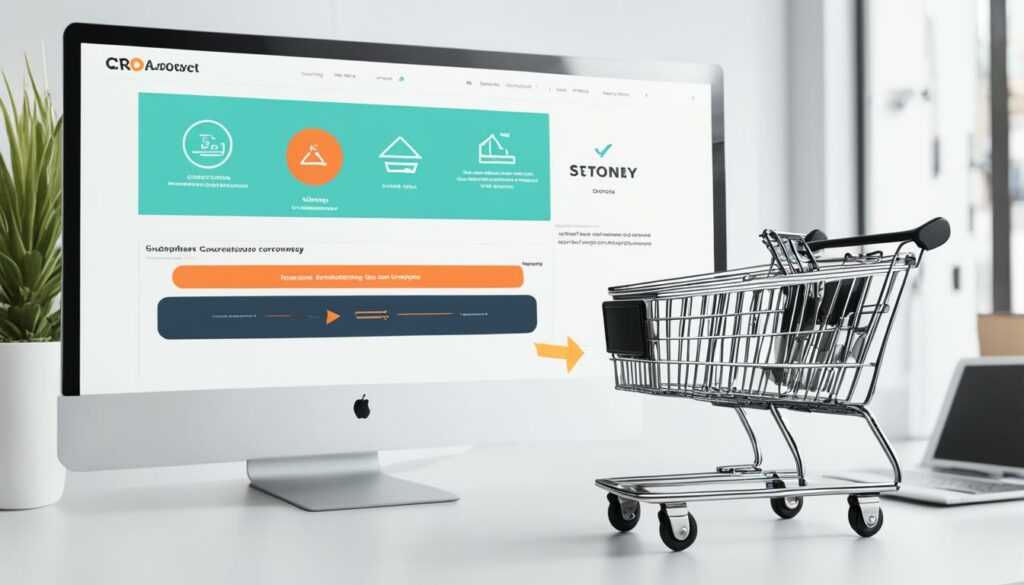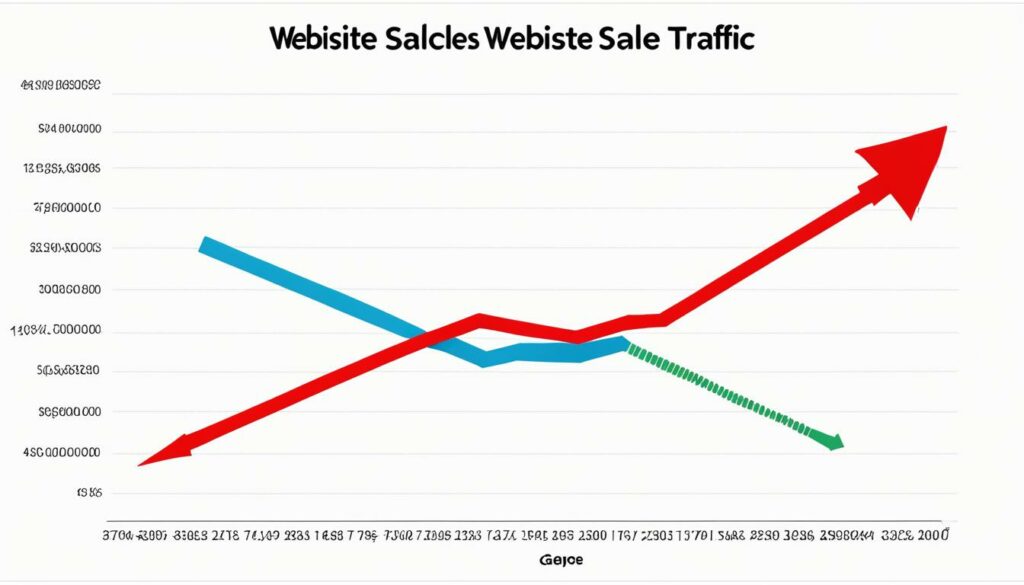Conversion rate optimization (CRO) is a crucial aspect of ecommerce marketing, with the primary goal of increasing the percentage of website visitors who take specific actions, such as making a purchase or signing up for a newsletter. By focusing on CRO, ecommerce businesses can improve their overall user experience and drive more conversions without increasing their marketing budgets.
To implement CRO effectively, businesses need to analyze and test various elements of their websites, such as product pages, blog posts, and landing pages. By identifying areas for improvement, they can optimize these elements and increase the chances of conversions. The average conversion rate for ecommerce websites is approximately 2.5-3%, but the ultimate aim is to continuously optimize and improve this rate for better results.
Key Takeaways:
- CRO in ecommerce focuses on increasing the percentage of website visitors who take desired actions.
- Analyzing and testing various elements of a website are crucial for optimizing conversion rates.
- The average ecommerce conversion rate is around 2.5-3%, but continuous optimization can lead to better results.
- Tools like Shopify Checkout, A/B testing, and heat maps can aid in implementing successful CRO strategies.
- By constantly analyzing data and making iterative improvements, ecommerce businesses can increase conversion rates and drive more sales.
Understanding Ecommerce Conversion Rates
Ecommerce conversion rates are an essential metric for evaluating the success of an online business. These rates represent the percentage of website visitors who take a desired action, such as making a purchase or subscribing to a newsletter. By understanding and optimizing conversion rates, ecommerce businesses can effectively convert clicks into sales and drive revenue.
Common ecommerce conversions include online sales, adding products to a cart, submitting email addresses, and clicking on links. The average conversion rate for online orders typically falls between 2.5% and 3%. However, it’s important to note that conversion rates can vary significantly across industries and businesses.
When establishing a benchmark for ecommerce conversion rates, it’s crucial to consider historical performance and industry standards. By analyzing past data, businesses can set realistic goals and evaluate their performance against peers in the industry.
While measuring the overall conversion rate is important, it’s equally essential to track other metrics that provide a comprehensive understanding of user behavior. Metrics such as bounce rate, exit rate, click-through rate, average session duration, and average page depth offer valuable insights into user engagement and the effectiveness of marketing efforts.
To accurately track and analyze these metrics, ecommerce businesses can leverage a variety of tools. Google Analytics is a widely-used platform that provides in-depth data and reports on website performance. HotJar offers heat maps and user recordings to visualize user behavior, while Quantcast Measure helps businesses gain insights into audience demographics and interests.
By continuously monitoring and optimizing conversion rates based on data-driven insights, ecommerce businesses can enhance the user experience, increase customer engagement, and ultimately drive more sales. The next section will cover strategies for improving ecommerce conversion rate optimization (CRO).
| Industry | Conversion Rate |
|---|---|
| Fashion and Apparel | 2.8% |
| Electronics | 2.4% |
| Home and Garden | 3.2% |
| Health and Beauty | 2.7% |
How to Improve Ecommerce CRO: 10 Strategies
Conversion rate optimization (CRO) is a crucial aspect of any successful ecommerce business. By implementing effective CRO strategies, you can maximize your website’s potential and turn more clicks into sales. Here are 10 strategies to consider:
- Optimize Your Website’s Loading Speed: A slow-loading website can lead to high bounce rates and abandoned carts. Optimize your website’s speed by compressing images, leveraging browser caching, and minimizing HTTP requests.
- Create Clear and Compelling Call-to-Actions (CTAs): Make it easy for visitors to take the desired actions on your website. Use persuasive and actionable CTAs that clearly communicate the value proposition.
- Implement A/B Testing: Test different variations of your website elements, such as headlines, images, and button colors, to identify what resonates best with your audience.
- Streamline the Checkout Process: Simplify the checkout process by reducing the number of steps and eliminating any unnecessary barriers. Offer guest checkout options and ensure a mobile-responsive design.
- Use High-Quality Product Images: Visuals play a crucial role in ecommerce. Use high-quality product images that showcase your products from different angles and provide zoom functionality.
- Offer Social Proof: Display customer reviews, ratings, and testimonials to build trust and confidence in your products or services.
- Personalize User Experiences: Utilize data-driven personalization techniques to deliver customized content and product recommendations based on customers’ preferences and browsing behaviors.
- Optimize for Mobile: With the rise of mobile shopping, it’s essential to ensure your website is mobile-friendly and responsive across various devices and screen sizes.
- Improve Website Navigation: Make it easy for visitors to find what they’re looking for by implementing clear navigation menus, search functionality, and intuitive category structures.
- Utilize Live Chat: Implement live chat support to provide real-time assistance to customers and address any concerns or questions they may have during the buying process.

Implementing these strategies can help you enhance your ecommerce CRO and boost your conversion rates substantially. However, it’s important to remember that every business is unique, so you may need to experiment and fine-tune these strategies to align with your specific target audience and goals.
The Importance of CRO in Ecommerce
Conversion rate optimization (CRO) plays a crucial role in the success of ecommerce businesses. By focusing on improving conversion rates, businesses can maximize their sales and revenue without the need for additional traffic acquisition. CRO allows businesses to understand user behavior, identify barriers to conversions, and make data-driven changes to enhance the overall user experience and increase the likelihood of conversions.
Implementing CRO best practices offers numerous benefits for ecommerce businesses. First and foremost, it leads to lower bounce rates, as users are more likely to stay and explore a website that is optimized for conversions. By reducing bounce rates, businesses can capture and retain more potential customers, increasing their chances of making a sale.
CRO also helps improve customer retention rates. By continually optimizing and enhancing the user experience, businesses can create a seamless, satisfying online shopping journey that keeps customers coming back for more. This not only boosts customer loyalty but also increases the lifetime value of each customer, resulting in long-term growth for the business.
Another advantage of CRO is the increased customer trust and loyalty it generates. When users have a positive experience on a website and easily find what they’re looking for, they are more likely to trust the business and become loyal customers. Building trust and loyalty is essential for ecommerce success and can lead to higher conversion rates and repeat purchases.
Ultimately, the goal of CRO is to improve the return on investment (ROI) for ecommerce businesses. By continuously testing and iterating on different website elements, businesses can optimize their conversion rates and drive more sales without increasing marketing budgets. This results in a higher ROI and a more cost-effective approach to generating revenue.
Overall, the importance of CRO in ecommerce cannot be overstated. It is a powerful strategy that allows businesses to maximize the value of their existing website traffic, improve user experience, and drive sustainable growth in a highly competitive online market.

| Benefits of CRO in Ecommerce | |
|---|---|
| Lower bounce rates | Reduced bounce rates indicate that users are engaged and more likely to convert. |
| Higher customer retention rates | A satisfying user experience leads to repeat customers and increased customer loyalty. |
| Increased customer trust and loyalty | Optimized websites build trust, leading to more conversions and loyal customers. |
| Improved ROI | By optimizing conversion rates, businesses can generate more sales without increasing marketing budgets. |
Customer Behavior and CRO
Understanding customer behavior is crucial for effective conversion rate optimization. By analyzing user behavior and making data-driven changes, businesses can enhance the user experience and increase conversions. Two key strategies for understanding customer behavior are user journey mapping and user testing for CRO.
User Journey Mapping
User journey mapping involves visualizing and analyzing the steps a user takes on a website before conversion. This process provides valuable insights into user behavior, pain points, and opportunities for improvement. By mapping out the user journey, businesses can identify areas where users might drop off or encounter difficulties, and make necessary changes to enhance the user experience.
“User journey mapping allows us to gain a deeper understanding of our customers’ needs and preferences. By identifying the touchpoints and pain points in their journey, we can optimize our website to provide a seamless and enjoyable experience.”
-Jane Smith, UX Designer at ABC Ecommerce Company
User Testing for CRO
User testing, both qualitative and quantitative, is an essential tool for gaining valuable feedback on user preferences, barriers, and opportunities for optimization. Qualitative user testing involves observing and interviewing users to understand their behaviors, attitudes, and motivations. This type of testing provides rich insights into how users interact with a website and can uncover usability issues or areas for improvement.
Quantitative user testing involves analyzing numerical data, such as click-through rates, conversion rates, and bounce rates, to measure the effectiveness of CRO strategies. By continuously monitoring and analyzing these metrics, businesses can identify trends, patterns, and areas that require optimization.
Combining User Journey Mapping and User Testing
By considering customer behavior and preferences in the design and optimization of a website, ecommerce businesses can improve user satisfaction, increase conversions, and ultimately drive more sales. User journey mapping and user testing for CRO go hand in hand, providing valuable insights into how users interact with a website and highlighting areas for improvement.
By implementing changes based on these insights, businesses can optimize the user experience, reduce barriers to conversion, and ultimately improve the overall success of their CRO efforts.
| Benefits of User Journey Mapping and User Testing for CRO | Examples |
|---|---|
| Identify pain points in the user journey | Users encounter difficulties on the checkout page due to confusing design elements |
| Uncover usability issues and improve user experience | Users struggle to find product information on the website |
| Optimize conversion funnels and increase conversions | Users abandon their shopping cart during the payment process |
| Gain valuable insights into user preferences and behavior | Users prefer a simplified and streamlined checkout process |

By leveraging user journey mapping and user testing for CRO, ecommerce businesses can gain a deep understanding of their customers and make informed decisions to optimize their websites. This combination of strategies can lead to improved user satisfaction, increased conversions, and ultimately drive more sales.
Challenges and Considerations in CRO
Conversion rate optimization (CRO) is a powerful strategy for improving ecommerce sales, but it’s not without its challenges and considerations. One of the main challenges is the need for continuous testing and iteration. What works for one website or audience may not work for another, so businesses must adopt a data-driven approach. By relying on A/B testing and other analytical tools, ecommerce businesses can make informed decisions and optimize their conversion rates effectively.
Another consideration in CRO is finding the right balance between optimization and user experience. While it’s crucial to optimize for conversions, it should not come at the expense of a smooth and user-friendly experience. By prioritizing both conversion optimization and user experience, businesses can ensure long-term success and customer satisfaction.
The evolving landscape of ecommerce is also a factor to consider. To effectively optimize conversion rates, businesses must stay up to date with industry trends, technologies, and consumer preferences. Adapting and embracing new strategies and tactics is essential to drive sustainable growth and remain competitive in the online market.
By acknowledging and addressing these challenges and considerations, ecommerce businesses can navigate the CRO journey successfully and unlock the full potential of their conversion rates. Continuous testing, a focus on user experience, and staying informed about industry shifts are key to driving sustainable growth and maximizing the impact of CRO strategies.
FAQ
What is CRO in Ecommerce?
CRO stands for conversion rate optimization and is a marketing strategy focused on increasing the percentage of website visitors who take a specific action, such as making a purchase or signing up for a newsletter. It involves analyzing and testing different elements of a website to identify areas for improvement and enhance the overall user experience.
What are ecommerce conversion rates?
Ecommerce conversion rates refer to the percentage of website visitors who make a purchase or perform a desired action on an ecommerce website. Common ecommerce conversions include online sales, adding products to a cart, submitting email addresses, and clicking on links. The average ecommerce conversion rate for online orders is typically between 2.5% and 3%, although it can vary across industries.
How can I improve ecommerce CRO?
There are several strategies you can implement to improve conversion rate optimization in ecommerce. Some of these include optimizing product pages, simplifying the checkout process, offering personalized recommendations, improving website speed, and implementing social proof elements. A data-driven approach, continuous testing, and utilizing CRO tools can also help optimize conversion rates.
Why is CRO important in ecommerce?
CRO is important in ecommerce because it directly impacts sales and revenue. By focusing on improving conversion rates, ecommerce businesses can maximize the value and return from their existing website traffic. CRO allows businesses to understand user behavior, identify pain points or barriers to conversions, and make data-driven changes to enhance the user experience and increase the likelihood of conversions.
How does customer behavior impact CRO?
Customer behavior plays a vital role in CRO. Understanding how customers navigate and interact with your website is crucial for optimizing conversion rates. User journey mapping and user testing can provide valuable insights into user preferences, pain points, and opportunities for improvement. By considering customer behavior and preferences in the design and optimization of your website, you can improve user satisfaction, increase conversions, and ultimately drive more sales.
What are the challenges and considerations in CRO?
Some challenges in CRO include the need for continuous testing and iteration, the balance between optimization and user experience, and staying up to date with industry trends and consumer preferences. It’s important to take a data-driven approach, strike the right balance between conversion optimization and user experience, and stay informed about the evolving ecommerce landscape to effectively optimize conversion rates.
